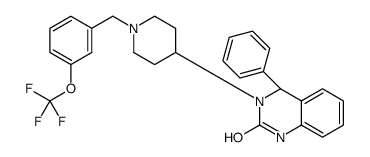Afacifenacin
Modify Date: 2024-07-06 14:00:02

Afacifenacin structure
|
Common Name | Afacifenacin | ||
|---|---|---|---|---|
| CAS Number | 877606-63-8 | Molecular Weight | 481.50900 | |
| Density | N/A | Boiling Point | N/A | |
| Molecular Formula | C27H26F3N3O2 | Melting Point | N/A | |
| MSDS | N/A | Flash Point | N/A | |
Use of AfacifenacinAfacifenacin (SMP-986) is a potent and orally active muscarinic receptor antagonist. Afacifenacin inhibits the bladder afferent pathway through the sodium-channel blockade, increasing volume, and reducing the frequency of urination and incontinence. Afacifenacin has the potential for the research of overactive bladder (OAB)[1][2]. |
| Name | (4S)-4-phenyl-3-[1-[[3-(trifluoromethoxy)phenyl]methyl]piperidin-4-yl]-1,4-dihydroquinazolin-2-one |
|---|---|
| Synonym | More Synonyms |
| Description | Afacifenacin (SMP-986) is a potent and orally active muscarinic receptor antagonist. Afacifenacin inhibits the bladder afferent pathway through the sodium-channel blockade, increasing volume, and reducing the frequency of urination and incontinence. Afacifenacin has the potential for the research of overactive bladder (OAB)[1][2]. |
|---|---|
| Related Catalog | |
| In Vivo | Afacifenacin (0.3, 1, 3 mg/kg; Intragastric administration) 显着增加脑梗死大鼠的膀胱容量和降低排尿压力 (MP)[2]。 Animal Model: Male Sprague-Dawley rats (cerebral infarction model)[2] Dosage: 0.3, 1, 3 mg/kg Administration: Intragastric administration Result: Significantly increased bladder capaticy and reduced micturition pressure (MP) without affecting residual urinary volume (RUV). |
| References |
| Molecular Formula | C27H26F3N3O2 |
|---|---|
| Molecular Weight | 481.50900 |
| Exact Mass | 481.19800 |
| PSA | 48.30000 |
| LogP | 5.51170 |
| UNII-XQU62QZ74P |
| Afacifenacin |